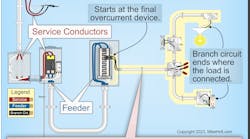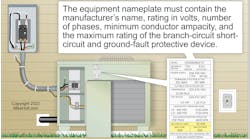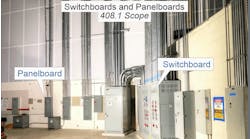The ampacity of a conductor is the maximum current it can carry continuously, under the conditions of use, without exceeding its temperature rating [Article 100 Definition]. The key concept is “under the conditions of use.” You must determine what those conditions are so you can select the appropriate ampacity table and then apply the appropriate correction factors.
The number of conductors bundled together is one of the conditions that determines which ampacity table to use. For example, Table 310.15(B)(16) lists conductor ampacities under the condition of no more than three current-carrying conductors bundled together in an ambient temperature of 86˚F.
Temperature Correction
When installing conductors in an ambient temperature other than 78˚F to 86˚F, you must use the appropriate multiplier(s) listed in Table 310.15(B)(2)(a) to correct the Table 310.15(B)(16) ampacities [Sec. 310.15(B)(2)(a)].
When correcting conductor ampacity for elevated ambient temperature, the correction factor used for 90˚C insulated conductors is based on the 90˚C rating of the conductor. If the conductor is dual-rated, such as a THWN/THHN rating, you must use the 75˚C rating of the conductor if in a wet location.
That’s because the wet location will require the use of the THWN characteristics, and THWN is a 75˚C rated conductor [Table 310.104(A)].
THWN-2 is an insulation type that’s acceptable in a wet location and is rated for 90˚C in either a wet or dry location. When raceways are installed in wet locations, the conductors inside them are considered to be in wet locations and must be of a type allowed in wet locations [Secs. 300.5(B), 300.9, and 310.10(C)].
How do you determine the ambient temperature for the application of the ampacity correction per Table 310.15(B)(2)(a) where raceways or cables are exposed to direct sunlight and located less than 7/8 in. above the roof? Add 60˚F (33˚C) to the outdoor ambient temperature [Sec. 310.15(B)(3)(c)]. Exception: Type XHHW-2 insulated conductors aren’t subject to that temperature adder.
Ampacity Adjustment
When conductors are bundled, their ability to dissipate heat is reduced. So, the ampacity of a conductor must be reduced whenever four or more current-carrying conductors are bundled together. Where four or more current-carrying power conductors are within a raceway longer than 24 in. [Sec. 310.15(B)(3)(a)(2)] — or where cables are bundled for longer than 24 in. — you must reduce the ampacity of each conductor per Table 310.15(B)(3)(a).
The “number of conductors” is the total number of conductors, including spare conductors, adjusted per Sec. 310.15(B)(5) and (B)(6). It doesn’t include conductors that can’t be energized at the same time.
Attend One of EC&M’s Upcoming Code Change Conferences Taught by Mike Holt:
St. Louis 2020 Code Change Conference | October 29-30, 2019
Philadelphia 2020 Code Change Conference | November 12-13, 2019
Seattle 2020 Code Change Conference | December 11-12, 2019
Boston 2020 Code Change Conference | January 28-29, 2020
Massachusetts Amendments Session | January 28, 2020 (evening)
The conductor ampacity adjustment of Table 310.15(B)(3)(a) doesn’t apply to conductors in cable trays (Sec. 392.80 applies to those) [Sec. 310.15(B)(3)(a)(1)] or raceways not longer than 24 in. [Sec. 310.15(B)(3)(a)(2)] — nor does it apply to conductors within Type AC or Type MC cable under the following conditions [Sec. 310.15(B)(3)(a)(4)]:
a. The cables don’t have an outer jacket,
b. Each cable has no more than three current-carrying conductors,
c. The conductors are 12 AWG copper, and
d. No more than 20 current-carrying conductors (ten 2-wire cables or six 3-wire cables) are installed without maintaining spacing for a continuous length longer than 24 in. Exception: A 60% adjustment factor applies if the
number of current-carrying conductors in these cables exceeds 20, and they are stacked or bundled for more than 24 in.
Where more than one ampacity applies for a given circuit length, you must use the lowest ampacity value. When different ampacities apply, the higher ampacity can be used for the entire circuit if the reduced ampacity length doesn’t exceed 10 ft or 10% of the length of the higher ampacity, whichever is less [Sec. 310.15 (A)(2), Exception].
The Table 310.15(B)(3)(a) adjustment factors apply only when there are more than three current-carrying conductors bundled together. All phase conductors are considered current-carrying.
The following factors help determine if the neutral conductor is considered a current-carrying conductor for the conductor ampacity adjustment of Sec. 310.15(B)(3)(a) [Sec. 310.15(B)(5)]:
• Both the neutral and ungrounded conductors of a 2-wire circuit carry current. So, both are considered current-carrying.
• The neutral conductor that only carries the unbalanced current of a 3-wire, single-phase, 120/240V circuit, or 4-wire, 3-phase, 120/208V or 277/480V wye-connected circuit, isn’t considered a current-carrying conductor (Fig. 1).
Fig. 1. Neutral conductors that carry only unbalanced current from other conductors from the same circuit aren’t considered current-carrying conductors.
• The neutral conductor of a 3-wire circuit from a 4-wire, 3-phase, wye-connected system carries about the same current as the line-to-neutral load currents of the other conductors. So, it’s considered a current-carrying conductor. In this situation, one of the line-to-neutral currents isn’t present and can be zeroed out of the neutral current formula.
• The neutral conductor of a 4-wire, 3-phase, 120/208V or 277/480V wye-connected circuit is considered a current-carrying conductor if more than 50% of the neutral load consists of nonlinear loads.
Also:
• Grounding and bonding conductors aren’t counted when adjusting conductor ampacity for the effects of conductor bundling [Sec. 310.15(B)(6)].
• Wireways are commonly used where access to the conductors within the raceway is required to make terminations, splices, or taps to several devices at a single location. When more than 30 current-carrying conductors are installed in any cross-sectional area of the wireway, the conductor ampacity, as listed in Table 310.15(B)(16), must be adjusted per Table 310.15(B)(3)(a) [Sec. 376.22(B)].
• The allowable ampacity as listed in Table 310.15(B)(16) must be corrected if the ambient temperature isn’t 86˚F from Table 310.15(B)(2)(a). It also must be adjusted if there are four or more current-carrying conductors bundled together, per the factors in Table 310.15(B)(3)(a).
Branch-Circuit Conductor Sizing Example
Section 210.19(A)(1) states that branch-circuit conductors cannot be sized less than the larger of Sec.210.19(A)(1)(a) or (b).
Question: All conductor terminals are rated 75˚C. What size branch-circuit conductor (THHN) is required for a 45A continuous nonlinear load that requires three ungrounded conductors and a neutral (four current-carrying conductors), as shown in Fig. 2?
Fig. 2. Here’s a good example of how to properly size a branch-circuit conductor.
Section 210.19(A)(1)(a): Since the load is 45A continuous, the conductor must be sized to have an ampacity of at least 56A (45A × 125%). Per Table 310.15(B)(16), 75˚C column [Sec. 110.14(C)(1)(a)(3)], a 6 AWG conductor is suitable because it has a rating of 65A at 75˚C before any conductor ampacity adjustment and/or correction is applied.
Section 210.19(A)(1)(b): Because the neutral is considered a current-carrying conductor per Sec. 310.15(B)(5)(c), there are four current-carrying conductors. Thus, we must apply the Table 310.15(B)(3) adjustment factor of 80%. Section 110.14(C)(1)(a)(2) permits the use of the THHN 90˚C ampacity rating for correction or adjustment.
6 THHN is 75A at 90˚C [Table 310.15(B)(16)]
The adjustment factor for four current-carrying conductors is 80% [Table 310.15(B)(3)(a)].
Corrected Ampacity = 75A × 80% = 60A, which is adequate for the 45A load.
The larger of Sec. 210.19(A)(1)(a) and (b) is 6 AWG THHN.
The minimum branch-circuit conductor size must have an allowable ampacity at least the maximum load to be served after the application of adjustment or correction factors.
Feeder Conductor Sizing Examples
Feeder conductors must be sized to the larger of Sec. 215.2(A)(1)(a) or Sec. 215.2(A)(1)(b).
(a) The minimum feeder conductor ampacity must be no less than 125% of the continuous load, plus 100% of the noncontinuous load, based on the terminal temperature rating ampacities as listed in Table 310.15(B)(16) [110.14(C)(1)].
(b) The minimum feeder conductor ampacity must be no less than the maximum load after any adjustment or corrections factors.
Question No. 1: What size feeder conductor (THHN) is required for a 200A continuous load (Fig. 3)?
Fig. 3. Here’s a good example of how to properly size a feeder conductor serving a continuous load.
Answer No. 1: Since the load is 200A continuous, the conductors must be sized to have an ampacity of at least 250A (200A × 125%). According to Table 310.15(B)(16), 75˚C column [Sec. 110.14(C)(1)(b)(1)], a 250kcmil conductor is suitable. That’s because it has an ampere rating of 255A at 75˚C before any conductor ampacity adjustment and/or correction is applied [Sec. 215.2(A)(1)(a)].
Since the question doesn’t specify any ampacity adjustments or corrections, the 250kcmil calculated in Sec. 215.2(A)(1)(a) is the larger of (a) and (b).
Question No. 2: What size feeder conductor (THHN) is required for a 100A continuous load and 100A of noncontinuous load
Answer No. 2: Since the load is 100A continuous and 100A noncontinuous, the conductors must be sized to have an ampacity of at least 225A (100A × 1.25 + 100A). According to Table 310.15(B)(16), 75˚C column [110.14(C)(1)(b)(1)], a 4/0 THHN conductor is suitable. That’s because it has an ampere rating of 230A at 75˚C before any conductor ampacity adjustment and/or correction is applied.
Since the question doesn’t specify any ampacity adjustments or corrections, the 4/0 AWG calculated in Sec. 215.2(A)(1)(a) is the larger of (a) and (b).
Right Size, First Time
It’s not just embarrassing when an acceptance inspection reveals conductors that are already installed are smaller than the Code minimum. It’s expensive in project cost and schedule ramifications. To get it right before installation, walk through your sizing process to check that you:
• Used the correct ampacity table for your conductor type and the number bundled together.
• Used the correct temperature column (the one for the lowest-rated device).
• Corrected for ambient temperature.
If the project includes performance expectations, the Code minimums might not be enough. But you must get those right so you have a sound basis for any upsizing decisions that involve non-Code factors such as voltage drop.
These materials are provided to us by Mike Holt Enterprises of Leesburg, Fla. To view additional Code training materials offered by this company, visit www.mikeholt.com.







